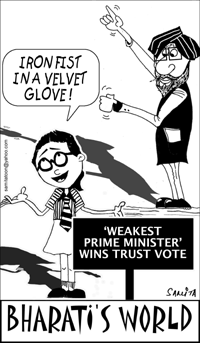West Bengal chief minister Buddhadev Bhattacharjee, rarely publicly eats humble pie. Yet at the 19th congress of the Communist Party of India (Marxist) or CPI(M), held at Coimbatore from March 28-April 3, when the subject of ‘education for all’ came up for discussion, that’s what he had to do.
At the two-day CPI(M) conclave, Bhattacharjee had to suffer scathing criticism from his fellow partymen for publicly conceding that West Bengal’s CPI(M)-led Left Front government, which has ruled the state since 1977, is way behind in implementing the Centre’s Sarva Shiksha Abhiyan (SSA) — Education for All — primary education programme.
SSA is India’s flagship programme for achievement of the United Nation’s Millennium Development Goal (MDG) of Universalisation of Elementary Education (UEE) in a time-bound manner. As earnest of India’s commit-ment to the MDG, the Constitution of India (Eighty Sixth Amendment) Act 2002 was passed by Parliament making State (i.e government) provision of free and compulsory education to all six-14 year old children a fundamental right.
 Currently SSA is being implemented in 50:50 partnership with state governments to cover the entire country and address the needs of 192 million children in 1.1 million habitations. The programme mandates state governments to start new schools in those habitations which do not have schooling facilities and strengthen existing school infrastructure through provision of additional classrooms, toilets, drinking water, maintenance and school improvement grants. Moreover under the programme the calibre of existing teachers is to be strengthened by extensive training, grants for developing teaching-learning materials, and by strengthening the academic support structure at the cluster, block and district levels.
Currently SSA is being implemented in 50:50 partnership with state governments to cover the entire country and address the needs of 192 million children in 1.1 million habitations. The programme mandates state governments to start new schools in those habitations which do not have schooling facilities and strengthen existing school infrastructure through provision of additional classrooms, toilets, drinking water, maintenance and school improvement grants. Moreover under the programme the calibre of existing teachers is to be strengthened by extensive training, grants for developing teaching-learning materials, and by strengthening the academic support structure at the cluster, block and district levels.
If Bhattacharjee is contrite, his cabinet colleague in charge of school education Partha De, isn’t. He flatly refuses to accept the Centre’s statistic that 50.54 percent of six-14 year old children in West Bengal have never attended any of West Bengal’s 50,275 government primaries (including upper primaries), of which 15 percent are single classroom institutions and 37 percent have more than 60 children per class, according to National University for Educational Planning and Administration data.
“The actual progress of SSA in the state is not as bad as what is being portrayed by the Centre. The pattern and criteria of assessment followed by the Centre are completely different from what is being followed in the state. It is due to this difference in the process of assessment that the state is being depicted as a poor performer,” he says.
According to the Union HRD ministry, the reasons behind West Bengal’s failure to implement SSA are: parents’ indifference to sending children to school, wipespread illness of children, shortage of teachers and poor infrastructure facilities in schools. But De is unmoved: “In order to counter the misleading figures (sic) of the Centre, my department is conducting a series of surveys. Preliminary studies show that our figures contradict those furnished by the Centre.”
Given that the Left Front government is in denial of the abysmal condition of primary education in the state where the ratio of upper primaries to primary schools is a pathetic 5.28 percent and 26 million citizens are comprehensively illiterate, it’s doubtful if the MDG goal of education for all will be met in West Bengal. According to the West Bengal Primary Teachers’ Association, primary schools get only Rs.47 per month from the state government to cover “contingencies”.
So where’s the money allocated by the Centre going? In Midnapore district, Prabal Maity, district project officer (SSA) says he gives the SSA amounts to the sub-inspector of schools (primary education), but cannot say how these funds have been utilised.
Sujoy Gupta (Kolkata)